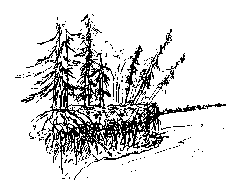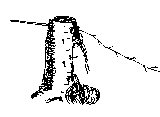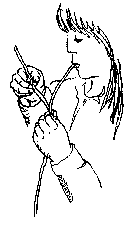Lessons & Units
A database
of lessons and units searchable by content and cultural standards,
cultural region and grade level. More units will be available soon.
You can use Acrobat Reader to look at the PDF version of the Cover
Sheet
for the Units and Self-Assessment
for Cultural Standards in Practice.
Digging and Preparing Spruce
Roots
|
Authors:
|
Iditarod Area School District
Alan & Helen Dick, Donna Miller
MacAlpine
|
|
Grade Level:
|
6-10
|
|
Context:
|
Two weeks in spring or tall when ground
is not frozen,
|
|
Region:
|
Interior Athabascan
|
GOALS:
1) Students will acquire the
knowledge and skill necessary to dig and prepare spruce roots
for use in various artifacts.
2) Students will know the traditional uses
of spruce roots.
3) Students will use scientific methods in
conducting experiments with spruce roots.
4) By working with elders students will
develop a traditional skill, acquire some knowledge of the
Native language and learn about the cultural tradition of their
responsibility to the environment.
Alaska Content Standards for Science and the
Cultural Standards for Students addressed by this unit are identified
and the skills and knowledge which are expected as learning outcomes
are listed under the standards.
NOTES TO THE TEACHER
This unit should be done in the fall before the
ground freezes, or in the spring after it thaws. It would be wise to
do this in the fall and get enough roots for all winter.
There are many uses I or spruce roots in the
traditional lifestyle, but digging roots is not fun in any stretch of
imagination There are few natural instincts that are satisfied in
digging under moss and tangled roots. Point: this is a necessary step
in the making of many Native crafts, but students will need
encouragement and positive reinforcement.
A junior high student who will follow directions
should be able to accomplish all parts of this unit and work
independently except perhaps, for the ride upriver or down river in a
boat). However, having an elder around when splitting the roots would
be helpful.
Boys will need to be reminded that men have always
dug roots for fish traps. Recent history has seen only women digging
roots for baskets, and boys might shy away from doing it unless they
realize that it is a job for men as well as women
This unit cannot be divided into five equal and
easy to administer lessons, but rather follows the natural division
of the topics/activities which need to be done. It is suggested that
the teacher plan the unit to best suit the class and local schedule.
The lesson topics are as follows:
1) Getting ready - learning
about spruce roots and where to find them.
2) Gathering spruce roots - a
field trip to one
or more locations
3) Cleaning the roots
4) Splitting the roots
5) Using spruce roots
Text: Digging
and Preparing Spruce Roots by
Alan & Helen Dick, published by Iditarod Area School
District, 1997
Other references:
This is The Way We Make Our Baskets
by D. & M. Titus
Birch Bark Basket Making
Village
Science by Alan
Dick
[formerly Alaska
Alive, it is now Alaska Science Camps,
Fairs & Experiments] by Alan
Dick
From Skins, Trees, Quills and Beads,
IANA: "The Roots," pg. 11
SCIENCE: A student who meets the content
standard should
B-1 use the processes of science; these
processes include observing, classifying, measuring, interpreting
data, inferring, communicating, controlling variables, developing
models and theories, hypothesizing, predicting, and
experimenting.
Skills and Knowledge to be acquired by the
students:
1. Students will use the
processes of science to determine how to find and prepare the
best spruce roots.
2. Students will use the processes of
science to test the qualities of spruce roots and to compare
them to other materials for similar uses.
3. Students will be able to use spruce roots
for many different purposes, replacing other types of materials
when necessary.
CULTURAL STANDARDS: Students who meet these
cultural standards are able to:
A-4 practice their traditional
responsibilities to the surrounding environment;
C-1 perform subsistence activities in ways
that are appropriate to local cultural traditions;
D-5 identify and utilize appropriate
sources of cultural knowledge to find solutions to everyday
problems;
E-2 understand the ecology and geography of
the bioregion they inhabit;
Skills and Knowledge to be acquired by the
students:
1. Students will learn to
harvest spruce roots in a traditional manner, respecting the
environment and becoming familiar with the local
bioregion.
2. Students will learn from the words and
examples of old timers how spruce roots can be used in place of
modern products such as rope or wire.
LESSON 1: GETTING READY
Objectives:
1) Students will develop
rapport with old timers.
2) Students will make appropriate
preparations for gathering spruce roots.
3) Students will know where to look for
spruce roots.
Materials: Gathering and Preparing
Spruce Roots by Alan & Helen Dick
Activities:
1. Students should read and
discuss "Digging Roots", pg. 1-4 in the text.
2. Together draw a map of the local area,
putting in landmarks known to the students.
3. Students should go to old timers of the
area and find out from them where the best places are for
gathering roots. They should then record this information on
the maps.
4. Gather necessary tools and prepare for
travel.

LESSON 2: GATHERING
ROOTS
Objectives:
1) Students will have
multi-sensory experience gathering roots.
2) Students will develop writing skill in
describing the tactile experiences of digging roots.
Materials:
Hammer, axe, pocket knives
boat & motor, gas
proper clothing for a boating trip
Activities:
1. Quickly reread pages 1-4
in the text Review the maps and reports of old timers and
decide where are the best places to go to look for spruce
roots.
2. Travel to a site and check the roots you
can find there. If there are good ones, dig there. If not keep
looking; check other sites until you find a good one. Gather as
many roots as possible. Remember only spruce roots are
desirable. As you get the roots coil them and keep them in a
plastic sack. (note: this is an excellent day-time activity
during hunting season)
3. After returning from the trip mark on
your map the locations you visited. Be sure to indicate where
you got good roots.
4. Write a description of the feeling of
dirt in your hands and the moss under your fingernails as you
dig for roots. Describe the texture of the roots and of the
dirt. Were you surprised to find how long some of the roots
were? Did you taste the roots in order to tell spruce roots
from other roots? Are trees more complex than you thought
before? What other things did you find in the dirt?
5. Gather a few roots from willow, birch and
cottonwood. Compare them to some of your spruce roots: size,
shape, color, smell, etc. Make a chart to show the differences
in the roots.
LESSON 3: CLEANING THE
ROOTS
Objectives:
1) The students will be
proficient in the techniques of cleaning spruce roots.
2) The students will be able to list the
advantages and disadvantages of a given system of cleaning
roots.
|
Materials:
Digging and Preparing Spruce
Roots
Broom, hammer
Crisco
|

|
Activities:
1. Read "Cleaning the Roots," pg.5
in the text.
2. Have different members of the class try
the different methods and discuss them with the
class.
3. List the advantages and disadvantages of
each method on the board while cleaning the roots.
4. Clean hands after the session. Experiment
with different types of cleaners. Try the following to see
which works best at removing the gum:
- regular
hand soap
- dish detergent
- Tide or other strong laundry
soap
- Crisco or other oil
(Because both spruce gum and Crisco or other
grease are non-polar substances, the grease works best. For more
information check "Soap", pg. 79 in Village Science) NOTE:
You will still have to wash your hands with soap after the gum is
removed with Crisco!
To learn more about spruce gum check Alaska
Alive under "Spruce Gum", pg. 67-68.
LESSON 4: SPLITTING THE
ROOTS
Objectives:
1) Students will develop the
skill of splitting spruce roots.
2) Students will develop an appreciation for
the skill and ingenuity of the old timers.
Materials:
Cleaned roots from lesson 3
Old timer pocket knives.
Activities:
1. Read "Split the roots" in
the text, pg.8
2. Follow the directions in the book or if
possible get an old timer to help. This is the trickiest part
of working with roots and old timers could be a great
help.
3. If there is a shortage of roots, willows
from the roadside are good to practice splitting on, if they
are peeled first with a pocket knife.
4. Coil the split roots and put them
away.

LESSON 5: USING THE
ROOTS
Objectives:
1) Students will compare
spruce roots to other types of lashing and list the advantages
and disadvantages of each.
2) Students will list the uses of spruce
roots.
|
Materials:
spruce roots
nylon string
cotton string
|

|
Activities:
1. Put each material through
the following tests:
a) Which stretches the most when
pulled? (nylon) Which would make the sloppiest
lashing? (nylon)
b) Which can take the most twisting and
bending before breaking? (nylon and
cotton)
Would you use roots in place where there
was flexing and bending? (no)
c) Which is the most resistant to
abrasion? Try rubbing them against something rough as if
shining shoes. (Nylon and cotton do tray)
Which one would you use on a fish trap
when you are poor? (roots) Which one would you use on
a fish trap when you have lots of money? (None of them.
Buy the fish)
d) Which one(s) of these do you think
would rot easily? (Cotton is the worst, and nylon rots in
sunlight)
2. Practice tying the root knot until it is
mastered. How do you think the old timers know which knot is best?
Experiment with other types of knots to see why this one way is best.
Record number and types of knots tried and the results.
3. Brainstorm about all the possible uses of
spruce roots. Make a list -include traditional uses and any new ones that
you can come up with.
4. Consider the following questions.
Why did old timers get large supplies of
roots in the fall? (They didn't have any stores handy and
couldn't dig frozen ground if they need roots in
winter)
Why do people still use spruce roots on baskets
made primarily to sell to tourists?
(No one wants baskets made with synthetic
materials)

Handbook
for Culturally Responsive Science Curriculum by Sidney Stephens
Excerpt: "The information and insights contained in this document will be
of interest to anyone involved in bringing local knowledge to bear in school
curriculum. Drawing upon the efforts of many people over a period of several
years, Sidney Stephens has managed to distill and synthesize the critical ingredients
for making the teaching of science relevant and meaningful in culturally adaptable
ways." |